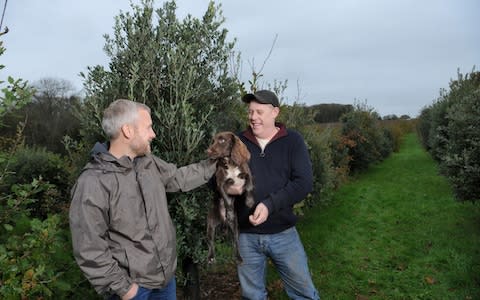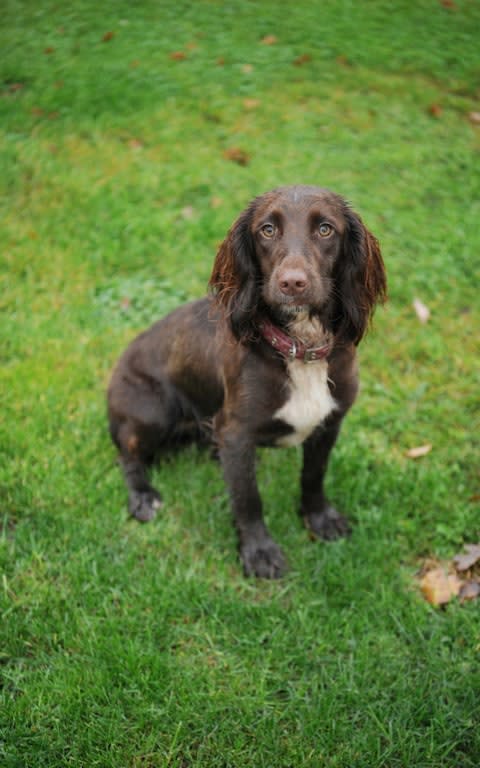The Welsh farm growing one of the world's rarest delicacies - the Perigord truffle

Bella the sprocker spaniel’s nose has disappeared into the earth and she’s furiously pawing the ground. It’s a rainy Welsh afternoon on Matt Sim’s farm in Monmouthshire, where lines of young hazel and Mediterranean oak cover fields rolling back from his cottage.
Planted fewer than 10 years ago, they’re already producing truffles and Bella, not even a year old, has proven herself an expert truffle hunter. In March, aged just 14 weeks, she unearthed a 16-gram (½oz) perigord black truffle, the first of its kind to be found in the UK and the farthest north the Mediterranean funghi, one of the world’s most prized ingredients, has ever been found.
Although Sim’s trees started producing more common summer truffles last year – his first discovery was in May – the winter truffles were always more of an experiment. But it’s a gamble that’s paid off.
“At first when I spotted something dark in the hole Bella was digging I thought it might be a rogue summer truffle,” says Sim. “But as soon as I smelt it I knew it was a perigord.”
I didn’t think they would grow, but I was proven wrong. And I’m quite happy to be
Dr Paul Thomas
The black truffle is one of the most expensive delicacies in the world, worth as much as £1,700 per kilogram (£770/lb) to the producer. Given that he planted the trees in lieu of a pension, Sim is unsurprisingly pleased: “Not just from a financial point of view. It’s fun. It’s great going out with the dogs and searching for truffles,” he says in his lilting Welsh accent.
As we walk the lines of trees Bella shoots in and out of sight with boundless energy. There’s not a moment to waste when she finds something. “You have to pull her off quite quickly. They’re very warty, the truffles, and the claws can pull those off and expose the flesh underneath,” explains Sim.

The 49-year-old is now truffle mad. “He’s obsessed,” says his wife, Sarah, back in their warm kitchen, cooking up truffle tortellini, from Aldi, for lunch. A bottle of Lidl truffle oil sits on the work surface.
Twice a day Sim walks the 11-acre orchard with Bella and Truffle, the aptly named Jack Russell trained to sniff out the prizes. Those he finds he often gives away to local chefs, or eats himself. “I generally just slice a bit off and eat them,” he smiles. Today though, there’s no such decadence. Those holes Bella dug? Simply mouse holes.
Truffle Numbers
Back in March though, when Bella came up with the goods, the first person Sim phoned was Dr Paul Thomas, who is behind the UK’s nascent truffle industry. His company Mycorrhizal Systems Ltd (MSL) has 30 UK plantations, as well as those in 22 other countries, as far away as Nepal. A keen forager as a teenager, he studied environmental science at the University of Sheffield and while there became intrigued by truffles. “I wanted to know why they were so hard to find,” says Dr Thomas.
Truffles grow below ground in a symbiotic relationship with the root system of trees in soils with high limestone content. More than 100 years ago there was a thriving industry in wild truffles, with Mrs Beeton one notable fan. But loss of woodland destroyed their habitat.
He explains: “The way it works is that if a seed drops beneath a tree with the fungus growing it becomes inoculated naturally. But once you’ve lost that habitat, there’s not a system for them to reproduce.”
Dr Thomas’s response was to hit the lab out of hours from studying for his PhD, to work out a process to inoculate the trees with the fungus.

Fast-forward 15 years and Dr Thomas, now 37, has a thriving business growing inoculated saplings on a site in Lancashire. In 2015, MSL successfully cultivated a UK native burgundy truffle. While predominantly involved in the academic side, he retains a 30 per cent interest in all the farms he provides with trees. “It’s a bit like a co-operative. We provided the trees essentially at cost price and do the consultancy and science for free.”
Sim, who doesn’t think of himself as a farmer (he works in the metal recycling business), was looking for something to do with the 11 acres of grassland attached to his cottage. Something, he says, with minimum input and maximum potential for returns. “There’s not really anything to do but treat the soil and wait. That’s what I thought in those days, but there’s actually quite a bit of work to do with upkeep and pruning,” he laughs.
In 2008, 4,900 hazel and oak saplings inoculated with summer truffle spores went into the ground, along with 100 winter truffle species. The summer trees started to show positive signs within nine months (five years is more typical), specifically a brûlé, a depression in grass growth around a tree that shows when truffles are growing well. In May 2016 Sim’s first summer truffle was discovered. The winter truffle followed less than a year later.
The Good Food Guide unveils 2018's top restaurants - but which seafood superstar stole the top spot?
Sim had wanted to plant more winter truffle species, but Dr Thomas was cautious. “I didn’t think they would grow but it might be interesting from a science perspective. I was quite bearish about it,” laughs Dr Thomas. “But I was proven wrong. And I’m quite happy to be!”
However, there’s a bittersweetness to the discovery of a perigord. Ordinarily Britain would be too cold for the winter truffles and Sim’s success suggests the effects of climate change. “The climate has already shifted one degree since the industrial revolution, two degrees by some estimations in certain regions,” says Dr Thomas. “We think that’s just enough to tip the balance.”
Having published his findings in the academic journal Climate Research this month, Dr Thomas is now working on modelling what areas of the country have the same microclimate of mild winters and warm summers as Sim’s farm. “What I want to do is kick-start the industry in the UK. We’ve got 30 sites, but it’s still small compared to Europe.”
Dr Thomas’s analysis comes at a time when the industry on the continent is in decline due to drought.
“France was producing 2,000 tons of truffles a year at the turn of the last century and now they produce maybe 50 or 80 tons,” he explains. “They’re planting trees but it’s not increasing. That’s a climate thing.”
Yields may be falling but global demand continues to rise. It’s a huge opportunity for British farmers with the time and patience to plant and nurture truffle woodlands. And indefatigable dogs like Bella are prepared to do the dirty work.

